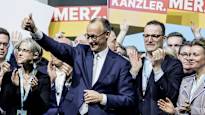In the German elections, older generations prefer Christian Democrats. In the eastern part of the country, the right -wing AfD did well.
14: 32 • Updated 14:33
In Germany, the Christian Democrats won the country’s parliamentary elections. The second highest number of votes was partly from the far -right AFD and the third left -handed SPD.
compiled four images that explain the election result.
This picture shows how the whole Germany colored in the downtown right and the right of the right:
According to statistics, poorer and less educated people live in eastern Germany than in the western part of the country. The tuoadic and social difference between the regions largely follows the border lines of the former eastern and western Germany.
In Eastern Germany, AfD was best succeeded, while in the West the CDU received a majority of the votes. Chancellor Olaf Scholzin The German Social Democratic Party, led by the German, even lost through the country.
In Eastern Germany, the light point of the left was Berlin. There, Left Party Linke collected as many as 19.9 percent of the vote and first became the largest party in the German capital.
This picture shows that right -wing parties are now dominating the Federation:
President of the Elections winning CDU Friedrich Merz The next step is to negotiate with other parties to form a government coalition.
Collaboration between the Christian Conservative CDU and the AFD, or the Alternative to Germany party, would guarantee a clear majority for the group at the country’s federal days. CDU and SPD would also have a scarce majority together.
However, Merz repeated the CDU line on Sunday evening: the party refuses to partially cooperate with the far-right AfD.
In the middle of this picture is one of the startling results of the election. One in four young people voted on the left party:
In the German elections, voters’ behavior predicted their age quite well.
The support of the populist left party linke is by far the highest among young people and the smallest in the group of older voters. Similarly, the support of the center -right CDU rises fairly evenly depending on the older group of voters.
The picture shows how much these elections meant to the Germans:
In Germany, voting activity increased clearly in all constituencies.
The turnout rose from 76.4 to 82.5 in the previous federation elections. This is the highest turnout in the country since the merger of Germany.
The most frequent election set was in Bavaria in the Munich Land constituency, where 88.1 percent of the voters were used.
